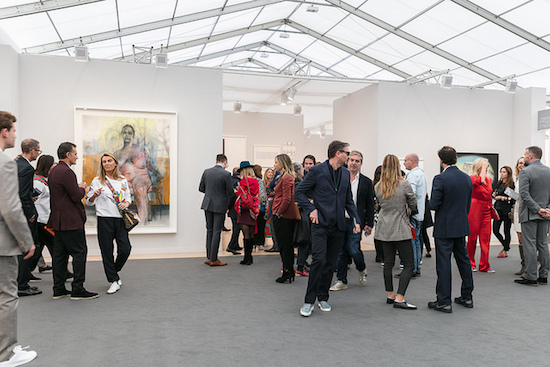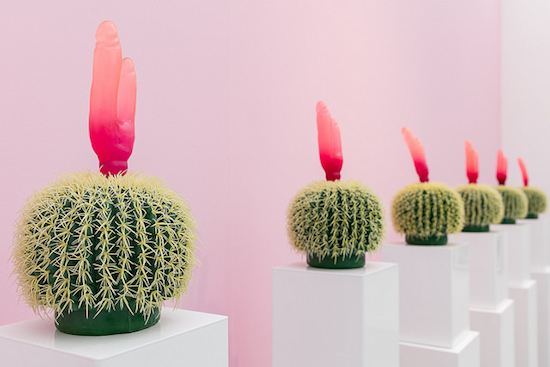It says quite a lot about the art market when you keep forgetting whether you’re in the big tent at Frieze Masters or the big tent at Frieze London. And not just because all those booths and that surfeit of art can start to feel disorientating. It’s because you’d expect the latter to be where you’ll find all the high-end contemporary stuff and the former to be full of, well, dead artists with even bigger reputations that have long gone beyond being subject to passing fads and fancies.
But not only does the 20th century canon dominate Frieze Masters, there’s a huge overlap between the two. Dead artists jostle beside the living on both sites and often it’s the same artist, living or dead, popping up in both. It’s almost like you’re seeing double.
There’s a good reason for this – at least a good commercial reason. This is a selling fair after all, though it’s one in which much curatorial effort is expended by the big exhibiting galleries who want to explore ‘themes’. But rich collectors, you see, don’t much go in for old art (although dealers in antiquities and the odd Rembrandt print are still dotted about in the Masters tent – a Rembrandt landscape, a rarity in his oeuvre, is a find at Emanuel von Baeyer’s booth, for instance). There are also a few dealers in antiquities, though fewer paintings that predate the nineteenth century. So encountering an early (1908) Mondrian at Jean-Luc Baroni, a small but striking painting of imposing haystacks, is quite something. It almost manages to put a quiet and unassuming landscape by Degas, in the nearby booth at Stephen Ongpin Fine Art, in the shade.
So these are just some of the artists you’ll find in both pavilions: Lynda Benglis, Robert Mapplethorpe, Robert Rauschenberg, Georg Baselitz, Sigmar Polke, Alberto Burri (worth mentioning the superb Masters stall of his combusted celotex canvases at Italian dealers Mazzoleni), Jean-Michel Basquiet (I suspect there are almost as many canvases at Frieze as at his current survey at the Barbican), and Ilya Kabakov (who has a Tate survey coming up). And that’s by no means an exhaustive list. Meanwhile, two sculptors who are exact contemporaries and both early winners of the Turner Prize – 1987 for Richard Deacon, and 1988 for Tony Cragg – could only be found in Masters and the main, contemporary tent respectively.
It’s a perversity, but none of this matters particularly, since Frieze is like one big hodge-podge of a jumble sale, and like a jumble sale offers many delights and discoveries. And if you’re a (very heavyweight) collector with extremely deep pockets, you may even discover a relative bargain or two. For the rest of us who can afford only to be merely curious, any effort that presents the work in interesting ways is to be welcomed. So while there are those critics this year who’ve attacked the curatorial efforts as ‘pretentious’ – no doubt also preferring the ‘honesty’ of an Ikea warehouse to an elaborately themed shop front at Fortnum & Masons, to step up from the jumble sale analogy – it’s no more pretentious than, say, a fashion show or, in fact, what exhibiting commercial galleries normally do when showing their artists.
So, what’s particularly striking this year? I’d say full marks on the curatorial front to Waddington-Custot’s Masters booth. They’ve recreated Peter Blake’s studio, though having once visited Blake’s real studio this staged version is somewhat messier, though in a very pleasingly higgledy-piggledy way. Blake’s been collecting pop artefacts, antique dolls, handcrafted bric-a-brac, vinyl albums, folk art, and other delightful trinkets, small and large (I almost stumble into a life-sized baby elephant) all his life. Put together they present something distinctly English and idiosyncratic, a fun house that’s also ripe with nostalgia.
At the other end of the aesthetic spectrum is Annely Juda’s spare and elegant arrangement of Anthony Caro sculptures from 1954 to 1972, while Cheim & Reid and Thomas Dane galleries have teamed up to pay similar homage to Lynda Benglis with an assortment of sculptural and video works from 1968 to 1990. But though her sculpture – which resembles bodily effluence – looks good, video installations, which do pop up elsewhere here and there, are completely unsuited to viewing at a big fair. You can’t hear them, there are rarely any headphones, and they look as if they’ve been installed as an afterthought on an exterior wall.
Elsewhere at Masters is Thaddaeus Ropac gallery’s presentation, 1984, apparently inspired by the spike in sales of Orwell’s novel since Trump took office and fake news has supposedly been on the rise. Big guns include Georg Baselitz, Jean-Michel Basquiat, Andy Warhol, Joseph Beuys, Robert Rauschenberg, and Gilbert and George, each with one work made in that eponymous year. And that’s really it. No theme is drawn beyond a date and a passing reference to a novel as a dead-end hook. Nul points for curatorial effort.

Frieze London 2017. Photo by Mark Blower. Courtesy of Mark Blower/Frieze
Over at Frieze London, it’s a better show at Hauser & Wirth’s Bronze Age c.3500BC – AD 2017, where Mary Beard was invited to contribute some ideas for loans of bronze age artefacts from an assortment of provincial museums around the country. These artefacts are shown alongside artists including Louise Bourgeois and the superb Hans Josephsohn, whose lumpen figurative sculptures are viscerally powerful. Hauser have gone as far as recreating a space that resembles a department of a fusty old museum and the attention to detail is both wonderful and amusing. It looks like Beard and the Hauser curators had some fun with this project.
But if this were the Chelsea Flower Show, an award for the most beautiful booth would go to the generously proportioned space given to Marian Goodman. It offers something of an oasis away from the crazy hustle of the fair. I think the point here was to create something like a Japanese Garden. A marble and bark tree by Giuseppe Penone, a sunken pond by Cristina Iglesias overgrown with a thick mattress of weeds and fronds in patinated bronze, a golden cascading ‘waterfall’ by Leonor Antunes, made from pieces of polished bronze, and a completely stunning work by Penone in which he’s created a wall-hanging triptych featuring two canvases either side of a slab of beautifully veined marble. Looking like a murmuration of starlings when viewed at a short distance, there are thousands of acacia thorns covering the surface of each canvas. If you’re planning a visit don’t miss this.
Individual works should also get a don’t miss mention: a delightful Magritte called Helmeted Sausage, from 1929, which is just that (I’ve never seen such a perfect painting of a frankfurter, frankly), and a great – and huge – Per Kirkeby abstract painting in the Michael Werner booth. Oh, and did I mention the sex? There’s a section called Sex Work, which features a selection of prominent feminist artists from the 70s. It’s right at the end of the tent, so you might already feel a little shagged out by the time you get to it.
Frieze London and Frieze Masters are both at Regent’s Park, until 8 October, 2017


